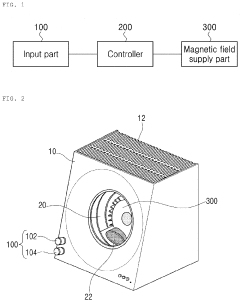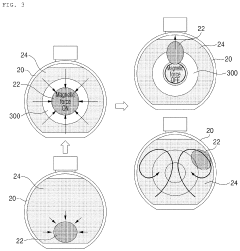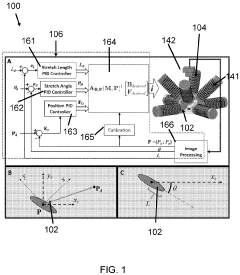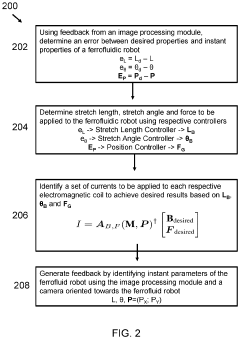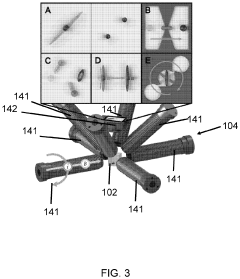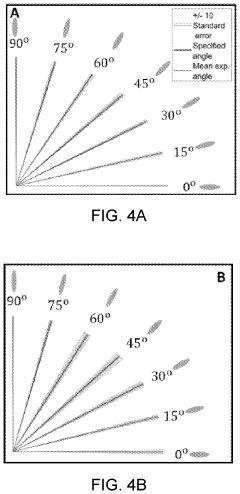How to Implement Ferrofluid in Motion Control Systems?
JUL 9, 20259 MIN READ
Generate Your Research Report Instantly with AI Agent
Patsnap Eureka helps you evaluate technical feasibility & market potential.
Ferrofluid Technology Evolution and Objectives
Ferrofluid technology has undergone significant evolution since its inception in the 1960s. Initially developed by NASA for rocket fuel control in zero gravity, ferrofluids have found applications across various industries due to their unique magnetic properties. The technology has progressed from basic magnetic fluid compositions to advanced nanoparticle-based formulations, enabling more precise control and manipulation.
The evolution of ferrofluid technology has been driven by advancements in material science, nanotechnology, and magnetic field control systems. Early ferrofluids were limited in their stability and responsiveness, but modern formulations offer enhanced performance characteristics, including improved thermal stability, reduced sedimentation, and increased magnetic susceptibility.
In the context of motion control systems, the objectives of ferrofluid technology have expanded significantly. The primary goal is to harness the fluid's ability to change viscosity and shape in response to magnetic fields, thereby enabling precise and adaptive control in various mechanical systems. This capability offers potential advantages over traditional hydraulic and pneumatic systems, particularly in terms of response time, energy efficiency, and system complexity reduction.
Current objectives in ferrofluid implementation for motion control systems include developing more robust and long-lasting ferrofluid compositions, enhancing the magnetic field generation and control mechanisms, and integrating smart control algorithms for real-time adaptation to changing conditions. Researchers and engineers are also focusing on miniaturization of ferrofluid-based actuators and sensors, aiming to expand their application in micro-electromechanical systems (MEMS) and robotics.
Another key objective is to improve the scalability of ferrofluid technology in motion control applications. While ferrofluids have shown promise in small-scale systems, there is ongoing research to overcome challenges associated with larger-scale implementations, such as maintaining uniform magnetic field distribution and managing heat generation in high-power applications.
The integration of ferrofluids with other emerging technologies, such as artificial intelligence and Internet of Things (IoT), represents a frontier in motion control systems. Objectives in this area include developing adaptive control systems that can learn and optimize performance based on operational data, as well as creating networked ferrofluid-based actuators for distributed control in complex systems.
As environmental concerns gain prominence, there is also a growing focus on developing eco-friendly ferrofluid formulations and implementing sustainable manufacturing processes. This aligns with the broader industry trend towards green technologies and circular economy principles in industrial applications.
The evolution of ferrofluid technology has been driven by advancements in material science, nanotechnology, and magnetic field control systems. Early ferrofluids were limited in their stability and responsiveness, but modern formulations offer enhanced performance characteristics, including improved thermal stability, reduced sedimentation, and increased magnetic susceptibility.
In the context of motion control systems, the objectives of ferrofluid technology have expanded significantly. The primary goal is to harness the fluid's ability to change viscosity and shape in response to magnetic fields, thereby enabling precise and adaptive control in various mechanical systems. This capability offers potential advantages over traditional hydraulic and pneumatic systems, particularly in terms of response time, energy efficiency, and system complexity reduction.
Current objectives in ferrofluid implementation for motion control systems include developing more robust and long-lasting ferrofluid compositions, enhancing the magnetic field generation and control mechanisms, and integrating smart control algorithms for real-time adaptation to changing conditions. Researchers and engineers are also focusing on miniaturization of ferrofluid-based actuators and sensors, aiming to expand their application in micro-electromechanical systems (MEMS) and robotics.
Another key objective is to improve the scalability of ferrofluid technology in motion control applications. While ferrofluids have shown promise in small-scale systems, there is ongoing research to overcome challenges associated with larger-scale implementations, such as maintaining uniform magnetic field distribution and managing heat generation in high-power applications.
The integration of ferrofluids with other emerging technologies, such as artificial intelligence and Internet of Things (IoT), represents a frontier in motion control systems. Objectives in this area include developing adaptive control systems that can learn and optimize performance based on operational data, as well as creating networked ferrofluid-based actuators for distributed control in complex systems.
As environmental concerns gain prominence, there is also a growing focus on developing eco-friendly ferrofluid formulations and implementing sustainable manufacturing processes. This aligns with the broader industry trend towards green technologies and circular economy principles in industrial applications.
Market Demand for Ferrofluid-based Motion Control
The market demand for ferrofluid-based motion control systems has been steadily growing, driven by advancements in precision engineering and the increasing need for sophisticated control mechanisms across various industries. Ferrofluids, with their unique properties of being both magnetic and liquid, offer innovative solutions to traditional motion control challenges.
In the aerospace and defense sectors, ferrofluid-based motion control systems are gaining traction due to their ability to provide precise and responsive control in extreme environments. These systems are particularly valuable in satellite stabilization, where minute adjustments are crucial for maintaining optimal positioning. The space industry's expansion, including the rise of private space companies, has further fueled the demand for advanced motion control technologies.
The automotive industry represents another significant market for ferrofluid-based motion control. As vehicles become more electrified and autonomous, the need for precise and efficient control systems increases. Ferrofluids offer potential applications in adaptive suspension systems, vibration damping, and even in advanced braking mechanisms. The global shift towards electric vehicles has amplified this demand, as these vehicles require more sophisticated control systems for optimal performance and energy efficiency.
In the field of robotics and automation, ferrofluid-based motion control systems are attracting attention for their potential to enhance precision and responsiveness. Industries such as manufacturing, healthcare, and logistics are exploring the integration of these systems to improve the capabilities of robotic arms, surgical robots, and automated production lines. The growing trend of Industry 4.0 and smart manufacturing is expected to further boost the demand for advanced motion control technologies.
The consumer electronics sector also presents opportunities for ferrofluid-based motion control. Applications in haptic feedback systems, camera stabilization in smartphones, and advanced gaming controllers are being explored. As consumers demand more immersive and responsive devices, the market for innovative motion control solutions expands.
While the potential applications are vast, the market for ferrofluid-based motion control systems is still in its early stages. Challenges such as the high cost of production, the need for specialized expertise, and concerns about long-term stability and maintenance of ferrofluid systems need to be addressed to accelerate market adoption. However, ongoing research and development efforts are focused on overcoming these hurdles, promising a bright future for this technology.
As industries continue to seek more precise, efficient, and adaptable motion control solutions, the demand for ferrofluid-based systems is expected to grow. The unique properties of ferrofluids offer advantages that traditional mechanical or hydraulic systems cannot match, positioning this technology as a key player in the future of motion control across multiple sectors.
In the aerospace and defense sectors, ferrofluid-based motion control systems are gaining traction due to their ability to provide precise and responsive control in extreme environments. These systems are particularly valuable in satellite stabilization, where minute adjustments are crucial for maintaining optimal positioning. The space industry's expansion, including the rise of private space companies, has further fueled the demand for advanced motion control technologies.
The automotive industry represents another significant market for ferrofluid-based motion control. As vehicles become more electrified and autonomous, the need for precise and efficient control systems increases. Ferrofluids offer potential applications in adaptive suspension systems, vibration damping, and even in advanced braking mechanisms. The global shift towards electric vehicles has amplified this demand, as these vehicles require more sophisticated control systems for optimal performance and energy efficiency.
In the field of robotics and automation, ferrofluid-based motion control systems are attracting attention for their potential to enhance precision and responsiveness. Industries such as manufacturing, healthcare, and logistics are exploring the integration of these systems to improve the capabilities of robotic arms, surgical robots, and automated production lines. The growing trend of Industry 4.0 and smart manufacturing is expected to further boost the demand for advanced motion control technologies.
The consumer electronics sector also presents opportunities for ferrofluid-based motion control. Applications in haptic feedback systems, camera stabilization in smartphones, and advanced gaming controllers are being explored. As consumers demand more immersive and responsive devices, the market for innovative motion control solutions expands.
While the potential applications are vast, the market for ferrofluid-based motion control systems is still in its early stages. Challenges such as the high cost of production, the need for specialized expertise, and concerns about long-term stability and maintenance of ferrofluid systems need to be addressed to accelerate market adoption. However, ongoing research and development efforts are focused on overcoming these hurdles, promising a bright future for this technology.
As industries continue to seek more precise, efficient, and adaptable motion control solutions, the demand for ferrofluid-based systems is expected to grow. The unique properties of ferrofluids offer advantages that traditional mechanical or hydraulic systems cannot match, positioning this technology as a key player in the future of motion control across multiple sectors.
Current Challenges in Ferrofluid Motion Control Systems
The implementation of ferrofluid in motion control systems faces several significant challenges that hinder its widespread adoption and practical application. One of the primary obstacles is the complexity of accurately modeling and predicting ferrofluid behavior under various magnetic field conditions. The non-linear nature of ferrofluid dynamics makes it difficult to develop precise control algorithms, especially in dynamic environments where rapid changes in magnetic fields are required.
Another major challenge lies in the stability and long-term reliability of ferrofluid-based systems. Ferrofluids can degrade over time due to oxidation, particle agglomeration, and carrier fluid evaporation, potentially leading to inconsistent performance and reduced system lifespan. This necessitates the development of more stable ferrofluid formulations and improved sealing techniques to maintain system integrity.
The temperature sensitivity of ferrofluids poses additional complications for motion control applications. As temperature fluctuates, the viscosity and magnetic properties of the fluid can change significantly, affecting its response to applied magnetic fields. This temperature dependence requires sophisticated compensation mechanisms to ensure consistent performance across a wide range of operating conditions.
Scaling ferrofluid-based motion control systems for larger applications presents another set of challenges. While ferrofluids have shown promise in small-scale devices, translating these successes to larger, industrial-scale systems has proven difficult. Issues such as magnetic field strength requirements, fluid volume management, and heat dissipation become more pronounced at larger scales.
The integration of ferrofluid systems with existing motion control technologies and infrastructure is also a significant hurdle. Many current motion control systems are not designed to accommodate the unique properties and requirements of ferrofluids, necessitating substantial modifications or complete redesigns of existing equipment.
Furthermore, the cost-effectiveness of ferrofluid-based motion control systems remains a concern. The specialized nature of ferrofluids and the complexity of the associated control systems can result in higher initial costs compared to conventional motion control solutions. This economic factor often deters potential adopters, particularly in industries where cost-sensitive applications are prevalent.
Lastly, there is a notable lack of standardization in ferrofluid technology for motion control applications. The absence of industry-wide standards for ferrofluid properties, testing methodologies, and performance metrics makes it challenging for engineers and designers to compare different solutions and ensure compatibility across systems. This lack of standardization also hampers the development of a robust supply chain and ecosystem for ferrofluid-based motion control technologies.
Another major challenge lies in the stability and long-term reliability of ferrofluid-based systems. Ferrofluids can degrade over time due to oxidation, particle agglomeration, and carrier fluid evaporation, potentially leading to inconsistent performance and reduced system lifespan. This necessitates the development of more stable ferrofluid formulations and improved sealing techniques to maintain system integrity.
The temperature sensitivity of ferrofluids poses additional complications for motion control applications. As temperature fluctuates, the viscosity and magnetic properties of the fluid can change significantly, affecting its response to applied magnetic fields. This temperature dependence requires sophisticated compensation mechanisms to ensure consistent performance across a wide range of operating conditions.
Scaling ferrofluid-based motion control systems for larger applications presents another set of challenges. While ferrofluids have shown promise in small-scale devices, translating these successes to larger, industrial-scale systems has proven difficult. Issues such as magnetic field strength requirements, fluid volume management, and heat dissipation become more pronounced at larger scales.
The integration of ferrofluid systems with existing motion control technologies and infrastructure is also a significant hurdle. Many current motion control systems are not designed to accommodate the unique properties and requirements of ferrofluids, necessitating substantial modifications or complete redesigns of existing equipment.
Furthermore, the cost-effectiveness of ferrofluid-based motion control systems remains a concern. The specialized nature of ferrofluids and the complexity of the associated control systems can result in higher initial costs compared to conventional motion control solutions. This economic factor often deters potential adopters, particularly in industries where cost-sensitive applications are prevalent.
Lastly, there is a notable lack of standardization in ferrofluid technology for motion control applications. The absence of industry-wide standards for ferrofluid properties, testing methodologies, and performance metrics makes it challenging for engineers and designers to compare different solutions and ensure compatibility across systems. This lack of standardization also hampers the development of a robust supply chain and ecosystem for ferrofluid-based motion control technologies.
Existing Ferrofluid Motion Control Solutions
01 Magnetic field control for ferrofluid motion
Utilizing magnetic fields to control the movement and shape of ferrofluids. This technique involves applying external magnetic fields to manipulate the ferrofluid's behavior, allowing for precise control over its motion and configuration. The method can be used in various applications, including sealing, damping, and display technologies.- Magnetic field control for ferrofluid motion: Ferrofluid motion can be controlled by applying external magnetic fields. This technique allows for precise manipulation of the ferrofluid's shape, position, and flow characteristics. The magnetic field can be generated by permanent magnets or electromagnets, enabling dynamic control of the ferrofluid's behavior.
- Ferrofluid-based sealing and damping systems: Ferrofluids are utilized in sealing and damping applications, where their unique properties allow for improved performance in mechanical systems. These systems can include rotary seals, shock absorbers, and vibration dampers. The controlled motion of ferrofluids in these applications enhances system efficiency and reliability.
- Optical applications of ferrofluid motion control: Ferrofluids can be used in optical systems where their motion is controlled to achieve specific effects. This includes applications in displays, lenses, and optical switches. By manipulating the ferrofluid's shape and position through magnetic fields, various optical properties can be dynamically adjusted.
- Ferrofluid-based sensors and actuators: The controlled motion of ferrofluids is utilized in the development of sensors and actuators. These devices can detect changes in magnetic fields, acceleration, or orientation. Ferrofluid-based actuators can provide precise and responsive motion control in various applications, including robotics and automation.
- Thermal management using ferrofluid motion: Ferrofluids can be employed in thermal management systems where their motion is controlled to enhance heat transfer. This includes applications in cooling systems for electronics and other heat-generating devices. By manipulating the ferrofluid's flow and distribution, efficient heat dissipation can be achieved.
02 Ferrofluid-based mechanical systems
Incorporating ferrofluids into mechanical systems to enhance performance and functionality. This approach involves using ferrofluids in bearings, seals, and other mechanical components to reduce friction, improve heat dissipation, and increase overall system efficiency. The unique properties of ferrofluids allow for adaptive and responsive mechanical designs.Expand Specific Solutions03 Optical applications of ferrofluid motion control
Exploiting the optical properties of ferrofluids for display and imaging applications. This involves controlling ferrofluid motion to create dynamic optical effects, such as variable lenses, shutters, or displays. The ability to manipulate ferrofluids using magnetic fields allows for the creation of reconfigurable optical systems.Expand Specific Solutions04 Ferrofluid-based sensors and actuators
Developing sensors and actuators that utilize ferrofluid motion for measurement and control purposes. This includes creating devices that can detect changes in magnetic fields, acceleration, or orientation by monitoring ferrofluid behavior. Additionally, ferrofluid-based actuators can be designed to provide precise and controllable motion in response to magnetic stimuli.Expand Specific Solutions05 Thermal management using ferrofluid motion
Employing ferrofluids for advanced thermal management solutions. This approach involves using controlled ferrofluid motion to enhance heat transfer and dissipation in various systems. The ability to manipulate ferrofluids with magnetic fields allows for adaptive cooling solutions that can respond to changing thermal conditions.Expand Specific Solutions
Key Players in Ferrofluid and Motion Control Industries
The implementation of ferrofluid in motion control systems is an emerging field with significant potential for growth. The market is in its early stages, with increasing interest from various industries due to the unique properties of ferrofluids. While the market size is still relatively small, it is expected to expand as applications in precision engineering, robotics, and aerospace develop. Technologically, the field is advancing rapidly, with companies like Koninklijke Philips NV, GM Global Technology Operations LLC, and LORD Corp. leading research and development efforts. These firms are exploring innovative ways to integrate ferrofluids into motion control systems, improving precision and efficiency. However, the technology is not yet fully mature, and further advancements are needed to realize its full potential in commercial applications.
LORD Corp.
Technical Solution: LORD Corporation has developed advanced magnetorheological (MR) fluid technology for motion control systems. Their approach utilizes ferrofluids to create adaptive damping systems. The MR fluid contains magnetic particles suspended in a carrier fluid, which can change its viscosity when exposed to a magnetic field[1]. This allows for real-time adjustments in damping force. LORD's systems typically include sensors, a controller, and electromagnets to modulate the fluid's properties. The company has implemented this technology in automotive suspension systems, improving ride comfort and handling[2]. They have also explored applications in industrial machinery and aerospace, where precise motion control is critical[3].
Strengths: Rapid response time, wide range of controllable damping forces, and durability. Weaknesses: Complexity of control systems and potential for particle settling over time.
New Scale Technologies, Inc.
Technical Solution: New Scale Technologies has innovated in the field of piezoelectric motors and motion control systems. While not directly using ferrofluids, their technology complements ferrofluid applications in precision motion control. They have developed SQUIGGLE motors, which use piezoelectric ceramics to create ultrasonic vibrations, resulting in precise linear motion[4]. These motors can be integrated with ferrofluid-based systems to enhance overall performance. New Scale's focus on miniaturization has led to the development of micro-motion modules that can achieve sub-micron positioning accuracy[5]. Their technology has found applications in optics, medical devices, and aerospace industries, where precise motion control is crucial[6].
Strengths: High precision, compact size, and low power consumption. Weaknesses: Limited force output compared to larger actuators and potential for wear in certain applications.
Core Innovations in Ferrofluid Motion Control
Ferrofluid display control device
PatentPendingUS20230161185A1
Innovation
- A ferrofluid display control device featuring a transparent storage container with different specific gravities of ferrofluid and liquid, an input part for selecting frequency ranges, a controller for generating magnetic field control signals, and a single electromagnet to create directional and random movements of the ferrofluid in response to sound frequencies.
Systems and methods for controlling shape and position of a ferrofluid droplet
PatentActiveUS20220265379A1
Innovation
- A system comprising a ferrofluid droplet and an electromagnetic field generation system with a controller that determines and applies necessary magnetic field parameters to control the position and shape of the ferrofluid droplet, using PID controllers to adjust electric currents in electromagnetic coils to manipulate the ferrofluid's position, stretch angle, and stretch length.
Environmental Impact of Ferrofluid Technologies
The implementation of ferrofluid in motion control systems raises important environmental considerations that must be carefully evaluated. Ferrofluids, composed of nanoscale magnetic particles suspended in a carrier fluid, have unique properties that make them valuable for various applications, including motion control. However, their potential environmental impact requires thorough assessment.
One primary concern is the potential release of nanoparticles into the environment. While ferrofluids are designed to be stable, there is a risk of leakage or degradation over time, which could lead to the dispersion of magnetic nanoparticles. These particles, typically made of iron oxides, may persist in the environment and potentially interact with ecosystems in ways that are not yet fully understood. Research suggests that nanoparticles can be taken up by organisms and potentially bioaccumulate in food chains, raising questions about long-term ecological effects.
The production process of ferrofluids also warrants environmental scrutiny. The synthesis of magnetic nanoparticles often involves chemical processes that may generate hazardous waste or consume significant energy. Sustainable manufacturing practices and proper waste management are crucial to mitigate these impacts. Additionally, the carrier fluids used in ferrofluids, which can be water-based or oil-based, may have their own environmental implications if released.
On the positive side, the use of ferrofluids in motion control systems can potentially lead to more efficient and precise operations, which could indirectly benefit the environment by reducing energy consumption and improving overall system performance. The ability to create adaptive and responsive systems using ferrofluids might result in longer-lasting and more durable equipment, potentially reducing waste from frequent replacements.
End-of-life considerations for ferrofluid-based systems are another critical aspect. Proper disposal and recycling protocols must be developed to prevent environmental contamination. This includes methods for safely separating the magnetic nanoparticles from the carrier fluid and recycling or neutralizing both components. The development of biodegradable carrier fluids and environmentally benign magnetic particles is an area of ongoing research that could significantly improve the environmental profile of ferrofluid technologies.
As the adoption of ferrofluid-based motion control systems increases, it is essential to conduct comprehensive life cycle assessments to fully understand their environmental impact from production to disposal. This holistic approach will help identify areas for improvement and guide the development of more sustainable ferrofluid technologies. Regulatory frameworks may need to be adapted to address the unique challenges posed by nanomaterials in industrial applications, ensuring that environmental protection keeps pace with technological advancements in this field.
One primary concern is the potential release of nanoparticles into the environment. While ferrofluids are designed to be stable, there is a risk of leakage or degradation over time, which could lead to the dispersion of magnetic nanoparticles. These particles, typically made of iron oxides, may persist in the environment and potentially interact with ecosystems in ways that are not yet fully understood. Research suggests that nanoparticles can be taken up by organisms and potentially bioaccumulate in food chains, raising questions about long-term ecological effects.
The production process of ferrofluids also warrants environmental scrutiny. The synthesis of magnetic nanoparticles often involves chemical processes that may generate hazardous waste or consume significant energy. Sustainable manufacturing practices and proper waste management are crucial to mitigate these impacts. Additionally, the carrier fluids used in ferrofluids, which can be water-based or oil-based, may have their own environmental implications if released.
On the positive side, the use of ferrofluids in motion control systems can potentially lead to more efficient and precise operations, which could indirectly benefit the environment by reducing energy consumption and improving overall system performance. The ability to create adaptive and responsive systems using ferrofluids might result in longer-lasting and more durable equipment, potentially reducing waste from frequent replacements.
End-of-life considerations for ferrofluid-based systems are another critical aspect. Proper disposal and recycling protocols must be developed to prevent environmental contamination. This includes methods for safely separating the magnetic nanoparticles from the carrier fluid and recycling or neutralizing both components. The development of biodegradable carrier fluids and environmentally benign magnetic particles is an area of ongoing research that could significantly improve the environmental profile of ferrofluid technologies.
As the adoption of ferrofluid-based motion control systems increases, it is essential to conduct comprehensive life cycle assessments to fully understand their environmental impact from production to disposal. This holistic approach will help identify areas for improvement and guide the development of more sustainable ferrofluid technologies. Regulatory frameworks may need to be adapted to address the unique challenges posed by nanomaterials in industrial applications, ensuring that environmental protection keeps pace with technological advancements in this field.
Safety Considerations for Ferrofluid Motion Control
The implementation of ferrofluid in motion control systems necessitates careful consideration of safety aspects to ensure the protection of both operators and equipment. Ferrofluids, being composed of nanoscale magnetic particles suspended in a carrier fluid, present unique safety challenges that must be addressed throughout the design, operation, and maintenance phases of motion control systems.
One primary safety concern is the potential for ferrofluid leakage or spillage. Given the magnetic properties of ferrofluids, any escape from the containment system could lead to contamination of surrounding equipment, potentially causing damage to sensitive components or interfering with other magnetic systems. To mitigate this risk, robust sealing mechanisms and containment strategies must be employed, including the use of chemically resistant materials and regular integrity checks of the fluid handling components.
The magnetic nature of ferrofluids also raises concerns about electromagnetic interference (EMI). Motion control systems utilizing ferrofluids must be designed with appropriate shielding to prevent unwanted interactions with nearby electronic devices or magnetic sensors. This is particularly crucial in environments where precision measurements or sensitive equipment operations are conducted concurrently.
Thermal management is another critical safety aspect. Ferrofluids can generate heat under the influence of magnetic fields, especially in high-frequency applications. Adequate cooling systems and temperature monitoring mechanisms should be integrated to prevent overheating, which could lead to degradation of the ferrofluid properties or damage to the motion control system components.
Handling and disposal of ferrofluids require specific safety protocols. Personnel working with these materials should be provided with appropriate personal protective equipment (PPE) to prevent skin contact or inhalation of ferrofluid particles. Proper disposal methods must be established to comply with environmental regulations and prevent potential ecological impacts.
Long-term exposure to strong magnetic fields associated with ferrofluid-based motion control systems may pose health risks to operators. Implementing proper shielding and establishing safe working distances are essential to minimize potential biological effects of prolonged magnetic field exposure.
Lastly, the stability of ferrofluids under various environmental conditions must be considered. Extreme temperatures, pressure changes, or exposure to certain chemicals could alter the properties of the ferrofluid, potentially compromising the safety and performance of the motion control system. Comprehensive testing under a range of operational conditions is necessary to ensure the reliability and safety of ferrofluid-based systems throughout their lifecycle.
One primary safety concern is the potential for ferrofluid leakage or spillage. Given the magnetic properties of ferrofluids, any escape from the containment system could lead to contamination of surrounding equipment, potentially causing damage to sensitive components or interfering with other magnetic systems. To mitigate this risk, robust sealing mechanisms and containment strategies must be employed, including the use of chemically resistant materials and regular integrity checks of the fluid handling components.
The magnetic nature of ferrofluids also raises concerns about electromagnetic interference (EMI). Motion control systems utilizing ferrofluids must be designed with appropriate shielding to prevent unwanted interactions with nearby electronic devices or magnetic sensors. This is particularly crucial in environments where precision measurements or sensitive equipment operations are conducted concurrently.
Thermal management is another critical safety aspect. Ferrofluids can generate heat under the influence of magnetic fields, especially in high-frequency applications. Adequate cooling systems and temperature monitoring mechanisms should be integrated to prevent overheating, which could lead to degradation of the ferrofluid properties or damage to the motion control system components.
Handling and disposal of ferrofluids require specific safety protocols. Personnel working with these materials should be provided with appropriate personal protective equipment (PPE) to prevent skin contact or inhalation of ferrofluid particles. Proper disposal methods must be established to comply with environmental regulations and prevent potential ecological impacts.
Long-term exposure to strong magnetic fields associated with ferrofluid-based motion control systems may pose health risks to operators. Implementing proper shielding and establishing safe working distances are essential to minimize potential biological effects of prolonged magnetic field exposure.
Lastly, the stability of ferrofluids under various environmental conditions must be considered. Extreme temperatures, pressure changes, or exposure to certain chemicals could alter the properties of the ferrofluid, potentially compromising the safety and performance of the motion control system. Comprehensive testing under a range of operational conditions is necessary to ensure the reliability and safety of ferrofluid-based systems throughout their lifecycle.
Unlock deeper insights with Patsnap Eureka Quick Research — get a full tech report to explore trends and direct your research. Try now!
Generate Your Research Report Instantly with AI Agent
Supercharge your innovation with Patsnap Eureka AI Agent Platform!
